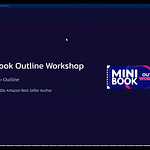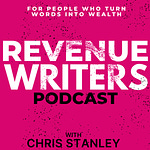Ever wonder how to structure a chapter that actually flows before you write a single word?
In today’s demo, I show you exactly how I outline a full chapter using Publisht, the tool I helped design to make book writing smarter and faster.
You’ll see me:
Use the W’s outline structure (what, who, why, where, how, when)
Talk through my outline live with the built-in AI assistant “Archie”
Build a full chapter map for my upcoming book The Fossil Workforce
And explain how outlining this way keeps your book focused, intentional, and fast to write
This is real. No polish. No prep. Just the process, right on screen.
If you’ve ever felt stuck starting a chapter—or unsure where it’s going—this is how I eliminate the guesswork.
Watch how I do it, then go outline yours.
P.S. I finished the rest of the book in 20 minutes after this video ended. This means I fully outlined a book in 30 minutes! See the full outline below.
Fossil Workforce Outline
Chapter 1
The Fossil Workforce Defined
What it is: Time plus pressure equals experience.
Why industries, especially insurance, leaned heavily on this traditional model.
Introducing the metaphor: fossil fuels as an analogy for experienced talent.
Symptoms of a Dried-Up Well
Fewer qualified candidates to fill rigidly-defined roles.
Rising recruitment costs, wasted resources, and slower hiring processes.
Heightened urgency: a race for dwindling talent in the market.
A Better Way to Strike Talent Gold (Solution Teaser)
Introducing a fresh approach: experience-free hiring as "XP-Free Talent."
Briefly outline the benefits: rapid talent pipeline creation, reduced hiring friction, new competitive advantages.
Set a clear expectation: by embracing potential over rigid requirements, we'll solve the workforce drought.
Chapter 2
Legacy Industries Clinging to Old Standards
Specific focus on insurance, banking, finance, and related legacy fields.
Common benchmarks: time-in-seat, formal degrees, and strict credentials as standard hiring criteria.
Credential-focused mindset: briefly naming the types of gatekeeping metrics without yet diving into why they stuck around.
Pre-AI Worldview: Experience as the Ultimate Benchmark
How industries once justified this approach (information was scarce, expertise was slow to build).
The outdated assumption: More years equals more knowledge equals less risk.
Why credentials and time-on-job USED TO BE a solid way to judge talent.
The AI Disruption: Knowledge at Everyone’s Fingertips
How AI has demolished the monopoly of time-based experience.
Immediate knowledge access vs. years spent learning or memorizing.
The shifting value: adaptability, fresh thinking, and nimbleness now outpace rigid experience requirements.
Chapter 3
Why the "Gold Standard" Was Actually Golden
Intense mentorship, shadowing, and memorization as prerequisites of competence.
Time-in-seat was essential—real hands-on experience was competence.
Degrees and certifications were the most reliable indicators of capability available.
Measuring Talent Before Metrics Existed
No tests or objective assessments meant reliance on indirect indicators.
Degrees, certificates, experience were about managing risk; they weren't arbitrary gatekeepers at the start.
Result: Credential-based hiring became the trusted benchmark to measure professional readiness.
What Got Us Here Won't Get Us There (Brief Nod—Not a Deep Dive Yet)
This standard built a strong foundation—produced genuine experts valued across industries.
Hint at new realities (tech, AI): These historical benchmarks are startin' to fray under new pressure.
Clearly signal: "Something changed" without detailing exactly how or why yet.
Chapter 4
Shut-Out Talent: Potential Candidates Who Never Got a Shot
Talent blocked at the start—interest but no entry due to rigid experience and credential requirements.
Frustration and roadblocks pushing promising candidates into other more accessible industries.
The quiet, constant drip of potential talent lost, steadily removing future workforce supply.
Leaking Talent: Experienced Professionals Driven Out by Pressure
The pressure-cooker environment: heavy workloads, unrealistic expectations, intense burnout.
Poor treatment and disposable attitudes toward seasoned adjusters, agents, and industry professionals.
The result: Skilled talent leaking out of the pipeline, further depleting the experienced workforce "well."
Empty Pipeline: Failure to Recruit and Refill
Complacency and lack of active recruitment or promotion of the industry's opportunities.
Assumptions that talent supply would naturally replenish itself—no drilling in new places.
Invisible industry: talented candidates never even knew opportunities existed—pipeline dries up completely.
Chapter 5
Rapid, Real-World Training: Forging a Talent Pipeline
Condensed, practical training designed to get talent job-ready in as little as 30 days.
Focused on skills, tools, and actionable performance—not time-in-seat or memorized information.
Drawing new talent pools: from homeschool moms to firefighters, coders to career-switchers—anyone with drive and dedication.
Certification & Competency Testing: Proof Over Promises
A rigorous, real-world assessment clearly proving candidates can perform the job—not just remember it.
The new hiring currency: Proven performance replaces years-of-experience or credential checklists.
Industry acceptance: Over 50 companies already waiving experience requirements based solely on competency certification.
Ongoing Mentorship: Sustained Support for Sustainable Talent
A full year of mentorship, practical advice, and professional guidance post-certification.
Mentors providing ongoing experience, filling the "experience gap" instantly.
Creating a truly renewable workforce: supported talent who start strong, stay confident, and continually improve.
Chapter 6
Days 1-30: Priming the Talent Pump (Finding and Preparing Your New Talent Pool)
Clear strategies for identifying eager, new-to-industry candidates (career-switchers, diverse backgrounds, overlooked groups).
How to clearly communicate opportunity to draw in fresh talent.
Setting expectations and creating systems so talent can immediately start training once selected.
Days 31-60: From Green to Certified (Rapid Training and Competency Certification)
Intensive, structured 30-day skill training and competency testing.
Certification as the key milestone—metrics clearly proving readiness to perform.
Ensuring your candidates emerge confident, competent, and industry-ready in a tighter window than previously imaginable.
Days 61-90: Culture, Community, and Confidence (Assimilating Talent Into Your Organization)
Intentional, deliberate onboarding—establishing your organization's culture clearly at the outset.
Realistic ramp-up: allow talent time to understand guidelines, processes, and expectations without immediate productivity pressure.
How mentorship and ongoing support ensures the assimilation of culture, creating a loyal, sustainable workforce that sticks.
TRANSCRIPT
All right, welcome back. I'm gonna go ahead and go through, uh, outlining a chapter two inside of Published. And so if you've been following along on this journey, I'm working on a book for the insurance industry, uh, called The Fossil Workforce, and now it's time to start outlining the chapters. Last time I worked with Archie, which is the architect AI tool, uh, inside of Publish to help me come up with chapters.
I worked a little bit on the titles offscreen, uh, but basically I'm using the W's outline. The what? The who, the why, the where, um, this is, uh, the how and then, uh, the win, and then a conclusion here. And so I'm gonna jump in and start, I outlining a chapter. Um, and I'm gonna start with the dry well, uh, which is the what.
And you can see here I have some filler stuff here. If you click on. This dropdown, it just reveals if you already have an outline in there, what it is. But I need to go in there and change it a little bit. Uh, but I need to go ahead and work with Archie, the AI tool and try to figure out what these points need to be.
So I'm going to talk, uh, and I'm going to use the tool that's built into the software to be able to talk to it. So it's a lot easier and you guys can follow along without watching me type. All right, so, uh, let's go ahead and try to outline the chapters we have. We already have our chapters outlined, um, Archie.
And so I wanna jump in and start outlining the dry well, which is the what, because we are using the W's uh, outline. We decided, and now, uh, I need to come up with the three points and then the three sub points per point. So let me know if you're ready for that.
So he is telling me to go ahead and get the three main points going. Well, I think. It. The dry well is about the fossil workforce. So the fossil workforce, let's go high level here, is the insurance industry has failed to hire talent unless it has a certain level of experience. Two to five years typically is what the experience requirements are, and that pushes out a lot of the best potential candidates because they're all potential.
They haven't had time and seat. And so the fossil workforce. Is experience that's built on time and pressure. It's the old standard, uh, that we've been using for decades of how to find talent. You have time, you have experience, you've been built under pressure, so therefore you are a fossil. Now your liquid gold to a recruiter, right?
Super valuable. Your oil straight out of the tap, but that well has run dry. So I think this first chapter needs to be just explaining it big picture like I just did. So maybe 0.1 is.
The fossil workforce and why those people are valuable. And then actually, you know what I'm gonna say? What do you think those three points need to be? Archie? I wanna see what you think, based on what I just told you. What do you think those three main points should be? Because I wanna see what you think.
Basically what I'm doing is I'm just trying to see how the system's working. 'cause I actually think I already know what they're gonna be, but I wanna see if he gives me a different perspective. All right. So right now here, what you're saying, the goal of this chapter's clearly the dry well, so he says, let's define the fossil workforce.
Oh, that's good. Uh, two. Why fossils become liquid gold. Yep. Perfect. And the well's gone dry. But now why this approach never works. And so I'm going to have a little more dialogue about this. I think that's a, a really good start and I could just run with that. But I want to outline and remind you what the other chapters are so we're not double talking.
Right. And I mean, this is a good overview. Maybe this first, just the overview, but chapter two is the industry that forgot to adapt. So it's the who. So that's the insurance industry and all really legacy. Industries that were built on these experience requirements. Uh, chapter three is from gold standard to gatekeeper, why this happened, why the fossil workforce ran dry.
Uh, four is the pipeline that cracked. So this is where the problem came from. And then five exp free, uh, the new talent strike. So that's the how and then the win is 90 days. Um. From drought to flow. And so that's the win of it. And then we'll do a conclusion after that. So knowing those chapter titles, Archie, do you think that outline you presented works or does it need tweaked?
Should maybe we just go high level. This first chapter kind of covers it, basically the book in a summary before diving in deep on each of these other elements in the, uh, subsequent chapter.
Now, uh, question. A lot of the books that I have read that are really good bestsellers in the first chapter, they lay out the big problem and often hint or even unveil the solution before going deep in the following chapters. Do you think that's something we should consider doing here, or do you think No, let's just set the stage and not even tell them what the solution would be?
'cause I feel like making them wait five chapters to find the solution might be too long to keep them in versus if we. Tell 'em what the solution is at the end of the first chapter. It, it might do better.
So they'll fossil workforce. Define what is it? Time pressure, equal experience. Why industries? Symptoms of a dried up. Well, a better way to strike talent. Gold. The solution teaser. Boom. That's the outline. We have three points. We have three subpoints. Um, I'm loving that. So let me add this in. I'm gonna copy it.
I'm gonna go over here to the dry, well hit edit and gonna add that in. And so now we've got a full outline. I can hit update. And I might get in there and there be a little things I wanna change here and there, but that is solid. So we got the fossil workforce defined. Sub 0.1 is, what is it? Time and pressure equals experience that explains that concept.
Why industries, especially insurance lead heavily on this traditional model. And then introducing the metaphor, fossil fuels as an analogy for experience talent. Perfect. It gives us the overview. And then, uh, 0.2 is symptoms of a dried well. Fewer qualified candidates to fill rigidly defined roles, rising recruitment costs, wasted resources, slower hiring processes, and heightened urgency.
A race for dwindling talent in the market. Yes, this is really stirring the problem in 0.2. And then 0.3 is a better way to strike talent and gold kind of the solution. Teaser, uh, introducing a fresh approach. Experience free hiring as exp free talent. Briefly outline the benefits, rapid talent pipeline creation, reduce hiring friction, new competitive advantages.
Set a clear expectation by embracing potential over rigid requirements will solve the workforce drought. Love it. That is a solid chapter and that's a chapter I feel really confident to write. And I don't think it's gonna give so much for people. Like I know exactly what he is gonna say the rest of the book, um, but it's gonna set up the book for context to know where we're going and I'm gonna update that.
And so that's how you outline a chapter. Now you can do this. And chat. GTP. You can do this on your own. I've outlined most of my books without ai. Um, and in like this book, I could have definitely done it, but I wanted to show you guys how I do it. If using ai, uh, and if, uh, and when we unlock published to those inside of the Revenue writers community on Substack, then you'll be, you can also, uh, use published here.
And what I like about this is I'm all in one, right? I, when I'm here and published, I am working exclusively on my book. And it's all in one place, and it does some really cool things that you're gonna see as time goes on. Um, but I'm slowly building it step by step. As I'm showing you guys, this is the first time I've done a full chapter outline in published live right here, because I want to show you what it's actually like.
Um, and then, so I'm gonna go and do the rest of these off camera. Uh, so you don't have to sit here and watch me do every single one, but that's how I do it, right? I go through, I kind of vomit. If I'm using ai, I vomit to ai what I wanna say in the chapter, and I will talk for three to five minutes, depending on the topic about it.
So there's a lot of context. I'm like, well, what do you think it is? Or if I know, I'll type 0.1, 0.2, 0.3 and try to map it out. I've used index cards in the past, sticky notes. I mean, I've done all sorts of crazy stuff. Uh, but three points, three sub points. Do it to each chapter before you start writing, because if you do that, your book's gonna be very, very focused.
Alright, get to it. Go outline your











